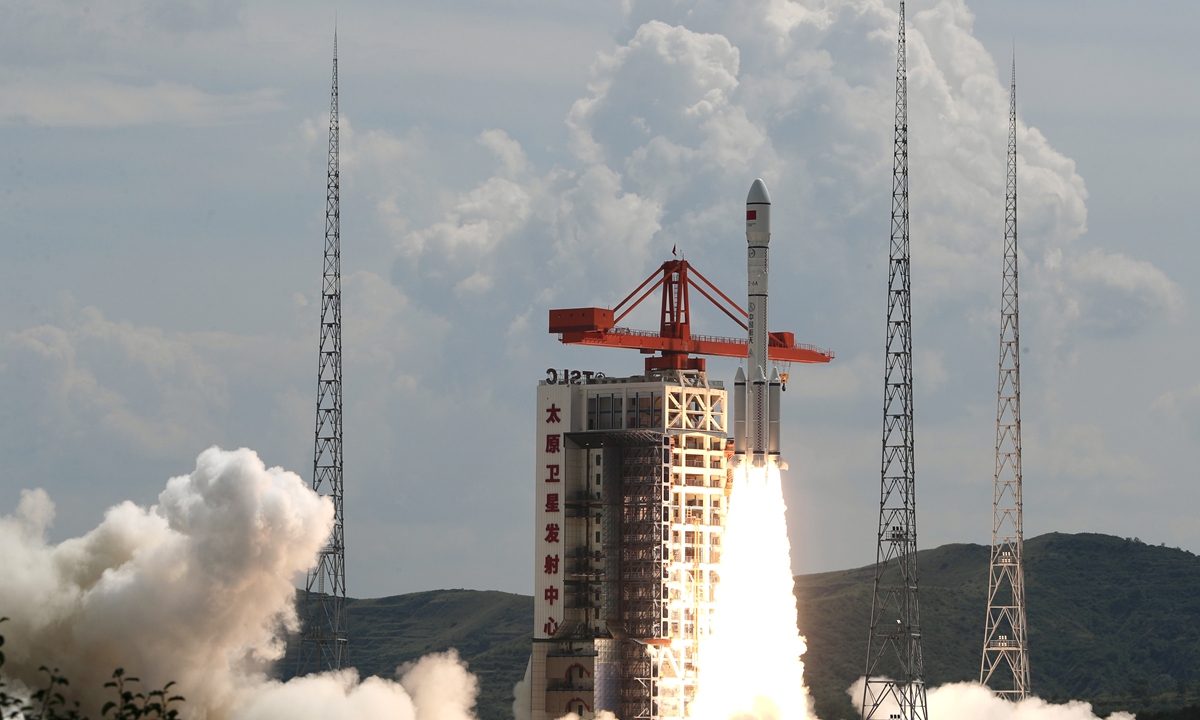
China successfully sends 18 Qianfan satellites into preset orbits via a Long March-6 carrier rocket launched from the Taiyuan Satellite Launch Center in North China's Shanxi Province on August 6, 2024. Photo: VCG
China successfully sent 18 Qianfan satellites into preset orbits via a Long March-6 carrier rocket launched from the Taiyuan Satellite Launch Center in North China's Shanxi Province on Tuesday. These are the first batch of satellites that will be used to establish the nation's "own version of Starlink," marking a "milestone event" for the country in the global satellite internet industry.
The Qianfan megaconstellation project, or G60, was launched in 2023 with the aim of providing more extensive and high-quality communication services for domestic users. It is expected to establish a network of over 15,000 low earth orbit (LEO) wide-screen multimedia satellites in the long run, according to media report.
"This will provide users with stable, high-speed internet services, especially in remote areas or regions with inadequate communication infrastructure, effectively bridging the digital gap," Kang Guohua, a senior member of the Chinese Society of Astronautics and a professor of Aerospace Engineering at Nanjing University of Aeronautics and Astronautics, told the Global Times on Tuesday.
This year, Qianfan is projected to complete the launch of 108 satellites, and by the end of 2025 achieve regional network coverage with 648 satellites. By 2027, the constellation aims to provide global network coverage, and ultimately by 2030, encompass 15,000 satellites providing integrated services such as direct mobile connections.
SpaceX's Starlink now has about 5,500 satellites in space and is used by consumers, companies and government agencies, according to Reuters.
"In recent years, the achievements of SpaceX's Starlink as a 'disruptor' in the internet communication industry have been widely recognized. With the launch and networking of the Qianfan constellation, China has begun to make strides in this field," Kang said.
Qianfan and Starlink both utilize advanced satellite communication technology and multi-layer, multi-orbit constellation designs. However, China's Qianfan constellation places more emphasis on the multimedia functionality and broadband communication capabilities of the satellites to meet the needs of different users, Kang noted.
In terms of market maturity, Starlink has already achieved significant success in the US market and is expanding globally, while Qianfan is currently focused on providing high-quality communication services to domestic users. However, as the project progresses and the technology matures, expanding the Qianfan constellation to the international market is in the "foreseeable future," the expert said.
Kang noted that the large-scale constellation construction of Starlink has led to increasingly tight space orbits, affecting the development of other countries in the space field. He called for global cooperation to address and resolve the resulting risk of satellite collisions and increased space debris.
The establishment of the Qianfan constellation is expected to accelerate development in markets such as mobile innovation, autonomous driving, disaster prevention and reduction, and the Internet of Things, bringing significant development opportunities to the satellite internet industry, observers said.
Compared to geostationary satellites in higher orbits, LEO satellites have various advantages in the field of communication, such as being closer in distance, having lower transmission delays, lower link losses, flexible launches, diverse application scenarios, and lower overall manufacturing costs.
Based on these advantages, countries around the world are actively deploying LEO satellite constellations, making it an emerging industry hotspot.
China currently has three megaconstellation projects with an expected scale reaching 10,000 satellites: the G60 project, the state-owned China Satellite Network Group Co.'s GW Constellation project and leading private space firm Landspace's Honghu-3 Constellation.
The GW Constellation is expected to launch a total of 12,992 satellites, while the Honghu-3 is planning to launch 10,000 satellites on 160 orbital planes. In total, the number of satellite applications in China has approached 40,000.
It is expected that in the next two to three years, China's commercial aerospace industry will experience "explosive growth," Dai Zheng, general manager of Rocket R&D of Landspace, told the Global Times in an earlier interview.
Starting in the second half of 2025 or the first half of 2026, China's satellite internet constellations will see high-density launches, Dai said.




